- Like
- SHARE
- Digg
- Del
- Tumblr
- VKontakte
- Flattr
- Buffer
- Love This
- Save
- Odnoklassniki
- Meneame
- Blogger
- Amazon
- Yahoo Mail
- Gmail
- AOL
- Newsvine
- HackerNews
- Evernote
- MySpace
- Mail.ru
- Viadeo
- Line
- Comments
- Yummly
- SMS
- Viber
- Telegram
- JOIN
- Skype
- Facebook Messenger
- Kakao
- LiveJournal
- Yammer
- Edgar
- Fintel
- Mix
- Instapaper
- Copy Link
 Sculpt, Trim, and Tone Your Upper Body With this Killer Chest Workout
Sculpt, Trim, and Tone Your Upper Body With this Killer Chest Workout
If you’re like a lot of ladies, you might know a good deal about your cardio options and your leg workout options, and not a whole lot about upper body workouts, specifically the chest. Most women’s upper body strength lags far behind their lower body strength. And it doesn’t have to be that way! A sculpted, strong chest will elevate your functional fitness a whole new level while giving you a super-fit look. Chest exercises are also great for working triceps, shoulders, and some chest exercises are even great for the biceps too. Additionally, but using large muscles, chest exercises are great for torching lots of calories and adding lean muscle to your frame. Therefore, chest exercises should absolutely be part of any fat loss program as well.
 DISCLAIMER ALERT! Right out of the gate, I need you to understand that no chest workout is ever going to burn fat DIRECTLY off the chest. For example, if you are trying to lose those little tucks of fat in front of your armpits or reduce the size of your breasts, it’s a mistake to put too much focus on chest workouts alone. Fat loss is a systemic process that happens across your whole body. Fat loss laughs in the face of the myth of spot reduction (i.e., the idea that you can do crunches to directly burn tummy fat or the inner thigh machine to directly burn inner thigh chub). Instead, you need to focus on a full-body strength training regiment as well as a smart cardio plan (more on that later). And you NEED to get your nutrition in line. Chest workouts can absolutely be a part of that picture, but you are sabotaging your progress if you over-focus on them to the exclusion of back, leg, and full body workouts, as well as cardio.
DISCLAIMER ALERT! Right out of the gate, I need you to understand that no chest workout is ever going to burn fat DIRECTLY off the chest. For example, if you are trying to lose those little tucks of fat in front of your armpits or reduce the size of your breasts, it’s a mistake to put too much focus on chest workouts alone. Fat loss is a systemic process that happens across your whole body. Fat loss laughs in the face of the myth of spot reduction (i.e., the idea that you can do crunches to directly burn tummy fat or the inner thigh machine to directly burn inner thigh chub). Instead, you need to focus on a full-body strength training regiment as well as a smart cardio plan (more on that later). And you NEED to get your nutrition in line. Chest workouts can absolutely be a part of that picture, but you are sabotaging your progress if you over-focus on them to the exclusion of back, leg, and full body workouts, as well as cardio.
Are you on board with me to cut the hype and learn the best ways to sculpt lean, strong pecs while losing body fat? Excellent, keep reading to learn my top tips for building both the functional strength and aesthetic quality of your chest musculature while ensuring muscle balance and sustainable fat loss. We’ll dig into the workout itself, of course, but we’ll also go over cardio considerations, nutritional guidelines, supplementation tips, and more.
The Pecs on Deck Best Chest Workout for Women
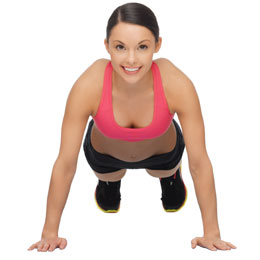 Here we go, ladies: it’s time to work these moves to give you the strong toned chest and arms you’re after. I’ll go over all the exercises to do, the best order in which to do them, as well as tips and tricks for maximizing your progress with every rep. Do these exercises as a circuit either alone or on the same day you do back and/or shoulders. Alternatively, blend them in with full body exercises on days you do full body to give your chest muscles some extra work they wouldn’t normally receive.
Here we go, ladies: it’s time to work these moves to give you the strong toned chest and arms you’re after. I’ll go over all the exercises to do, the best order in which to do them, as well as tips and tricks for maximizing your progress with every rep. Do these exercises as a circuit either alone or on the same day you do back and/or shoulders. Alternatively, blend them in with full body exercises on days you do full body to give your chest muscles some extra work they wouldn’t normally receive.
Tips and Guidelines for the Best Chest Workout for Women:
- Do the workout at least two but as many as four times through
- Work in a circuit from top to bottom
- Rest 60 seconds between the exercises (or a little longer if you are really lifting HEAVY)
- Don’t mess around with too light of weights; once you have mastered the form, be sure to push yourself
- That being said, always choose a weight that is reasonable enough to allow you to complete your set with good form
- Safety first: if you’re not sure how much weight to use, start by erring on the lighter side and going heavier next time if it was too easy
- Do all these chest exercises twice a week for optimal results
- Never train chest two days back to back; take at least 48 hours off in between chest workouts
The Best Chest Workout for Women: Main Circuit
The Warm Up
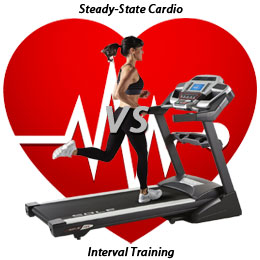 Always warm up before lifting weights. Do 5 minutes of light cardio (treadmill, elliptical, ARC trainer, anything standing up) to get the blood flowing to prep your muscles and connective tissues. Then do some active warm up moves: 10 shoulder circles back followed by 10 full arm circles back. If you are prone to tightness, stretch first by placing your forearm against a stationary object with your elbow at 90 degrees and your forearm vertical, twisting your torso away from the arm until you feel a good stretch across your chest and front of your shoulder. Hold for 20-30 seconds. Finish your warmup by going through the motions you will actually be doing but at a lighter weight: pushups! Find a countertop or even just the wall if you are a beginner, form a plank with your body, and do a set of 15-20 push ups to prepare your body to PUSH during the real workout. Once you’re warmed up, start the workout proper.
Always warm up before lifting weights. Do 5 minutes of light cardio (treadmill, elliptical, ARC trainer, anything standing up) to get the blood flowing to prep your muscles and connective tissues. Then do some active warm up moves: 10 shoulder circles back followed by 10 full arm circles back. If you are prone to tightness, stretch first by placing your forearm against a stationary object with your elbow at 90 degrees and your forearm vertical, twisting your torso away from the arm until you feel a good stretch across your chest and front of your shoulder. Hold for 20-30 seconds. Finish your warmup by going through the motions you will actually be doing but at a lighter weight: pushups! Find a countertop or even just the wall if you are a beginner, form a plank with your body, and do a set of 15-20 push ups to prepare your body to PUSH during the real workout. Once you’re warmed up, start the workout proper.
#1. Dumbbell Chest Press – 15 reps
The dumbbell chest press is a simply marvelous exercise for strengthening, building and toning the pectoral muscles while also working the shoulders. You’ll also strengthen and tone the triceps which goes a long way toward improving the look and the strength of your arms. Learning to control the dumbbells also helps build shoulder muscle stability while encouraging good range of motion in the shoulders. Chest press is really the meat and potatoes of any chest workout program. Can you tell I really love this exercise?! Start low on the weight until you get the form down pat; otherwise, it can be rough on your shoulders if you do too much too fast.
How to do dumbbell chest presses:
Grab dumbbells of an appropriately challenging weight and hold them to your chest as you roll back onto a bench or exercise ball. Plant your feet firmly on the floor. Put the dumbbells up over your face with straight arms and palms facing your legs. With a tight core, lower the dumbbells down toward the sides of your rib cage at about nipple level. This is the bottom of the movement. Don’t let your back arch excessively; use your core to keep your back strong. Keep your elbows close-ish to your sides and your forearms vertical as you PUSH into your feet, tighten your core, and breathe out…all as you press the weights back up to the starting position. Actively squeeze your chest muscles together as you approach the top position as if you’re trying to squeeze your boobs together! Keep your neck neutral the whole time. Avoid craning it forward or shifting from side to side. Always avoid letting your elbows flare up too high. If you can’t complete the set without your elbow starting to flare, you’re probably using too heavy of a weight.
#2. Dumbbell or Machine Chest Flies – 15 reps
Chest Flies are an excellent exercise for chest toning. They also give your biceps a little love, which never comes amiss.
How to do chest flies:
Choose less weight than you would for a chest press. Get into position on your back on a bench or exercise ball the same way you did for chest press. Position the weights over your chest with straight arms, but this time, make your palms face inward toward each other instead of facing your feet. Keep your palms facing inward the whole time. Put a slight bend in your elbow and lower the weights down until your arms are in a sort of T-shape coming out from the sides of your body. Maintain that elbow bend as if you are hugging a great big giant redwood tree. Don’t go so far down that you feel too strong of a stretch in your chest and shoulders; a little stretch is good but too much can cause injury. SQUEEZE your pec muscles together as your bring your arms back up to the starting position. The chest fly works your pec fibers from a different angle than the dumbbell chest press. You can also do this exercise on the chest fly machine at your gym, but I prefer to use free weights because you will build more shoulder stability and core strength that way. If you are an absolute beginner, it can be a good idea to practice on the chest fly machine before trying the free weight version, just so you can get the hang of the movement. Follow the instructions on the machine and don’t forget to actively engage your core by drawing your bellybutton in toward your spine.
#3. Dumbbell Pull Overs – 15 reps
The dumbbell pull over is a really interesting and effective exercise in that it strengthens your chest, triceps, and BACK at the same time. Most chest exercises leave out the back; that’s what makes this one really unique. It’s also great for building core strength.
How to do dumbbell pullovers:
Get one heavy dumbbell and get into position on your back on the bench or exercise ball just like you did for the chest press and the fly (the only difference being you will have one dumbbell instead of two). Hold the dumbbell handle with both hands and straighten your arms over your face. Get a slight bend in your elbows. It’s essential that you TIGHTEN YOUR CORE by pulling your navel in toward your spine as you execute the pullover. With control, lower the dumbbell backward behind your head and toward the floor. Keep going until you feel a nice stretch but nothing extreme. Using your chest AND back, strongly PULL the dumbbell back to the starting position. The weight of the dumbbell will make your back want to arch; combat this by keeping your core tight and strong throughout the movement.
#4. Bodyweight Push Ups – 15 reps
Push ups are an essential part of any chest workout. If you are into functional fitness and REALLY want to prioritize getting better at moving your bodyweight around, consider doing pushups as the first exercise in your circuit so you will knock them out while you have the most “juice” left. That way, you will get stronger at them more efficiently. All chest exercises will improve your ability to push, but if you want to move your own bodyweight around, there’s nothing like moving your own bodyweight to train for that.
How to do Push Ups:
Don’t start push ups on the floor! If you train push ups, you will eventually be able to push your bodyweight from the floor with no problem. Until then, don’t pressure yourself and begin your push ups by starting with your upper body at a higher angle. Simply put your hands onto a higher surface of your choice and do push ups from there. For example, you can use (in order of difficulty from easiest to hardest): the wall, a counter top, a weight bench, an aerobic step, or the floor. Being progressive will allow you to complete your full set of 15 with good form, which is the most important aspect of improving at push ups.
So what is good form? In a push up, you want a plank-like alignment from your ears down your shoulders, to your hips, to your ankles. Start with your hands shoulder-width apart. Keep your shoulders down and strong, never letting them creep up toward your ears. Keep your core tightened and even your glutes contracted to ensure as much plank-ness as possible. As you lower down into the push up, maintain those shoulders pressing downward and keep your elbows close to your sides; think elbow creases forward. Never flare your elbows out to the sides, because it’s really hard on your shoulders over time. As you reach the bottom of the push up, breathe out and tighten your core even more, squeezing your pecs together and your elbows inward. Be careful not to slam your elbows into a locked position at the top. That can lead to repetitive stress injuries over time as you continue to train push ups. Instead, finish with control. It really helps to breathe OUT as you push UP and envision pushing the wall/counter/bench/floor/what have you AWAY from yourself like a bad habit instead of thinking about pushing your body weight.
So that completes the most important exercises to do in the Best Chest Workout for Women! Go through the circuit at least one more time and up to three more times for a total of four.
At this point, we have fatigued your chest muscles from multiple angles, worked on shoulder stability, built lots of functional strength, and even toned up the triceps to boot! NICE!
Question: Where is Barbell Bench Press?
 Of course, barbell bench press is an excellent exercise and a great traditional choice for training the chest. You might be wondering why I didn’t include the barbell bench press in this workout. It’s because the bench press is excellent for building pushing power in the chest, but it’s not the best exercise suited to women simply looking to tone and strengthen while maintaining flexibility. The Chest Press using dumbbells is a better choice for general fitness. Chest press allows you to move through a fuller range of motion for the chest and shoulders while building shoulder stability at the same time it works your pecs. In my experience, dumbbell chest press is more multipurpose and versatile than barbell bench press. That being said, if you get truly serious about weight training and/or powerlifting, the bench press is going to be an essential exercise to master and perform regularly. We have a few articles going over everything you need to know about bench pressing; try the following article as a starting point if you want to bench with a barbell: https://www.askthetrainer.com/how-to-bench-press/
Of course, barbell bench press is an excellent exercise and a great traditional choice for training the chest. You might be wondering why I didn’t include the barbell bench press in this workout. It’s because the bench press is excellent for building pushing power in the chest, but it’s not the best exercise suited to women simply looking to tone and strengthen while maintaining flexibility. The Chest Press using dumbbells is a better choice for general fitness. Chest press allows you to move through a fuller range of motion for the chest and shoulders while building shoulder stability at the same time it works your pecs. In my experience, dumbbell chest press is more multipurpose and versatile than barbell bench press. That being said, if you get truly serious about weight training and/or powerlifting, the bench press is going to be an essential exercise to master and perform regularly. We have a few articles going over everything you need to know about bench pressing; try the following article as a starting point if you want to bench with a barbell: https://www.askthetrainer.com/how-to-bench-press/
Essential Tips for Fitting Chest Workouts into Your Training Plan
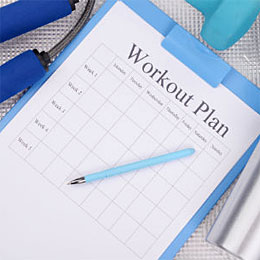 A chest workout alone isn’t a complete upper body training program. At best, a chest workout covers half your bases, the others being covered by shoulder workouts and ESPECIALLY back workouts. It’s especially important for muscle balance, posture, and functional strength to focus on working your back as well as your chest. You can do back and chest on the same day or you can split it up if you want your volume of either body part to be particularly high. However, most women are going to do well doing chest and back together as part of an upper body training day twice or three times a week, or as part of a full body workout plan three or four days a week. The scope of this article is too limited to cover all fitness planning options, but this workout contains all the essential exercises for your chest and can be used alone or stacked on the same day with a back workout or even blended into a full body workout.
A chest workout alone isn’t a complete upper body training program. At best, a chest workout covers half your bases, the others being covered by shoulder workouts and ESPECIALLY back workouts. It’s especially important for muscle balance, posture, and functional strength to focus on working your back as well as your chest. You can do back and chest on the same day or you can split it up if you want your volume of either body part to be particularly high. However, most women are going to do well doing chest and back together as part of an upper body training day twice or three times a week, or as part of a full body workout plan three or four days a week. The scope of this article is too limited to cover all fitness planning options, but this workout contains all the essential exercises for your chest and can be used alone or stacked on the same day with a back workout or even blended into a full body workout.
CARDIO Considerations for Chest Muscle Building and General Fitness
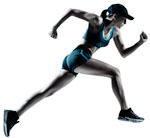 No matter what your fitness goals are, everyone needs some form of cardio! General guidelines for cardio health and maintenance for adults are 90 minutes of vigorous cardio per week or 120 minutes of moderate cardio. If you’re looking to lose body fat to strip off the excess and reveal those sculpted muscles underneath, you’re going to have to hit the cardio harder than that! Aim for 150 minutes of high-moderate cardio per week. Add intervals into your program a couple times per week to encourage your body to adapt more efficiently and shed body fat more quickly.
No matter what your fitness goals are, everyone needs some form of cardio! General guidelines for cardio health and maintenance for adults are 90 minutes of vigorous cardio per week or 120 minutes of moderate cardio. If you’re looking to lose body fat to strip off the excess and reveal those sculpted muscles underneath, you’re going to have to hit the cardio harder than that! Aim for 150 minutes of high-moderate cardio per week. Add intervals into your program a couple times per week to encourage your body to adapt more efficiently and shed body fat more quickly.
A cardio machine that actually allows you to use the pushing power of your chest and build endurance and tone in those specific muscles is the ARC trainer or even just an elliptical. These types of machines allow you to use your upper body along with your lower body to varying degrees. If you want more upper body, rely a bit less on your legs just push more with your arms, pushing from the chest and consciously contracting your chest muscles with each push.
Nutrition Notes for Chest Workouts
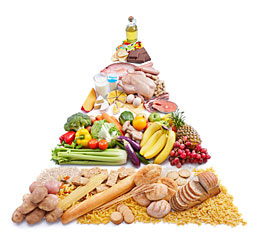 Let’s take a minute and talk about the importance of nutrition for women when doing chest workouts (and any muscle-building workouts, for that matter). I’m going to go ahead and assume you are NOT looking for lots of added bulk in your chest muscles, but rather the lean muscle look. I’m not downplaying bulking the chest; if you want to do that, that’s awesome and I totally support you. This article, however, is geared toward women looking for leanness and definition without much extra muscle bulk.
Let’s take a minute and talk about the importance of nutrition for women when doing chest workouts (and any muscle-building workouts, for that matter). I’m going to go ahead and assume you are NOT looking for lots of added bulk in your chest muscles, but rather the lean muscle look. I’m not downplaying bulking the chest; if you want to do that, that’s awesome and I totally support you. This article, however, is geared toward women looking for leanness and definition without much extra muscle bulk.
So that being said, let’s just go over the basics of eating to support muscle building and fat loss. First, the muscle building aspect. Your most important consideration is being smart about protein and carb intake. Eating adequate protein and carbs will cause your spare what muscle you already have from being used as fuel while allowing the gradual addition of lean muscle. A good general pointer is to eat one gram of protein per pound of lean body mass. That means if you weigh 140 pounds and you have 100 pounds of lean body mass (muscle, bone, organs, etc.) and 40 pounds of fat, you should shoot for about 100 grams of protein intake per day. This is easy to accomplish if you are an omnivore. Lean turkey breast, chicken breast, and Greek yogurt are your top three allies in terms of protein sources. You can also supplement your whole-food protein intake with whey protein powder. Whey protein isolate is your best choice if would like protein without sugar, artificial sweeteners, or other additives.
If you are a vegetarian or vegan, it becomes more difficult to get that level of protein intake even with supplementation. Eat your beans and rice (together they make a complete amino acid profile) and your quinoa. In terms of supplements, there are lots of great protein powders out there that don’t include animal products and are based on plant sources instead.
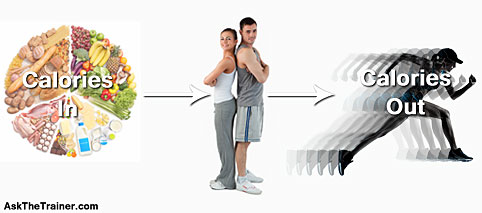 Another key aspect of fitness nutrition to mention is the importance of establishing a day by day, week by week calorie deficit. If you are looking to get leaner, that is, to lose excess body fat, you need eat fewer calories than you burn through basic daily metabolic processes, daily activities, and your workouts. I’m also going to assume you are not trying to get as lean as a bodybuilder or a physique competitor; you are just looking for sustainable, reasonable body fat loss to look and feel sleeker. In that case, many women will do well consuming (and this is a GENERAL recommendation) 1300-1500 calories when they are going for fat loss, muscle maintenance, and support for their energy levels.
Another key aspect of fitness nutrition to mention is the importance of establishing a day by day, week by week calorie deficit. If you are looking to get leaner, that is, to lose excess body fat, you need eat fewer calories than you burn through basic daily metabolic processes, daily activities, and your workouts. I’m also going to assume you are not trying to get as lean as a bodybuilder or a physique competitor; you are just looking for sustainable, reasonable body fat loss to look and feel sleeker. In that case, many women will do well consuming (and this is a GENERAL recommendation) 1300-1500 calories when they are going for fat loss, muscle maintenance, and support for their energy levels.
 AND (unless you are on a carb restricted diet such as Primal or Paleo where you train your body to burn dietary fat for fuel instead of carbs)…you DO need carbs. A smart amount of carbs! Carbohydrates, for one thing, help shuttle protein into your muscles so it can actually be utilized. For another thing, your muscles and especially your brain prefer to run off carbohydrates. So unless you want to be a brain-fogged muscle wasted mess, don’t cut out all carbs unless you know exactly how to do so following a Paleo or Primal-type plan. So go ahead and eat some whole wheat bread, pasta, potatoes, yams, dairy, etc. Just use portion control.
AND (unless you are on a carb restricted diet such as Primal or Paleo where you train your body to burn dietary fat for fuel instead of carbs)…you DO need carbs. A smart amount of carbs! Carbohydrates, for one thing, help shuttle protein into your muscles so it can actually be utilized. For another thing, your muscles and especially your brain prefer to run off carbohydrates. So unless you want to be a brain-fogged muscle wasted mess, don’t cut out all carbs unless you know exactly how to do so following a Paleo or Primal-type plan. So go ahead and eat some whole wheat bread, pasta, potatoes, yams, dairy, etc. Just use portion control.
We could talk nutrition tips all day, but this isn’t a nutrition article, so just use this info as guidelines when planning out your fitness nutrition. If you need more information on nutrition and diets, it’s an excellent idea to consult with a nutritionist, dietician, or personal trainer who is a fitness nutrition specialist, especially if you have a good deal of weight you would like to lost. They can create a custom meal plan that ensures your body is getting everything it needs to function optimally while shedding the excess fat.
Supplementation Tips for Chest Workouts for Women
 If you’re serious about getting results, be sure to eat enough protein like we talked about in the previous section, in the form of whole-food sources or high-quality protein supplements. Another supplement to consider adding to your regimen is creatine monohydrate. Simply put, creatine allows you to lift more weight by giving your muscles more power and more efficient energy production. Over time, this adds up to accelerated muscle building results because your workout volume is higher. Of course, that’s great, but a word of warning to some of you ladies: creatine can cause a little muscle bulking, or at least the appearance of bulking because it causes your muscles to retain fluids within the muscle cells. If you would like a little added muscle bulk and shape, go for it! If, on the other hand you want a super-sleek look and are afraid of adding any bulk, creatine might not be the best for you. You can always try it out and see what it does for you. Since the bulk at least in the early phases is just water uptake in the muscles, when you stop, they will go back to normal.
If you’re serious about getting results, be sure to eat enough protein like we talked about in the previous section, in the form of whole-food sources or high-quality protein supplements. Another supplement to consider adding to your regimen is creatine monohydrate. Simply put, creatine allows you to lift more weight by giving your muscles more power and more efficient energy production. Over time, this adds up to accelerated muscle building results because your workout volume is higher. Of course, that’s great, but a word of warning to some of you ladies: creatine can cause a little muscle bulking, or at least the appearance of bulking because it causes your muscles to retain fluids within the muscle cells. If you would like a little added muscle bulk and shape, go for it! If, on the other hand you want a super-sleek look and are afraid of adding any bulk, creatine might not be the best for you. You can always try it out and see what it does for you. Since the bulk at least in the early phases is just water uptake in the muscles, when you stop, they will go back to normal.
Creatine has been demonstrated to be effective as well as safe, as long as you consume adequate water and don’t have kidney or liver issues. When in doubt as to whether or not a certain supplement is a good fit for you, always ask your doctor.
Pecs on Deck Best Chest Workout for Women: The Bottom Line
So give this workout a shot for and get that strong and sculpted chest while maximizing calorie burn due to the recruitment of those hungry muscles! Did you get stronger, more lean, and more toned while doing this workout? Did we forget to add any of your favorite chest exercises for women? We always want feedback from our readers, so let us know in the comments below!
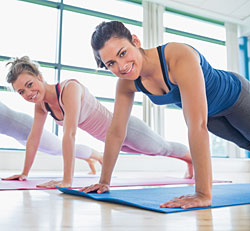
Best Chest Exercises for Women to See Optimal Results
Many women shy away from chest exercises, generally thinking one of two things: (1) that chest exercises consist of only the bench press and are only useful for male bodybuilders, or (2) that chest exercises will reduce their breast size.
Both of these notions are false. To address (1), there are many more chest exercises than the bench press, and chest exercises benefit everyone! You don’t need to use heavy weights for chest exercises, and even if you do lift heavy weights, ladies, you won’t bulk up like a bodybuilder; your body does not have the hormones for that type of muscle building. Your muscles will increase in size somewhat, but more importantly, they will become toned and defined. Moreover, chest exercises are the best way to train the motion of pushing, a key dimension of functional strength that everyone can benefit from improving.
And to shoot down misconception (2) once and for all, that chest exercises will reduce breast size, you need to know that spot reduction is a myth. In other words, working out your chest will not burn fat in that area. Nor will abdominal workouts burn your tummy fat. Fat loss is a much larger picture involving burning more calories than you consume. Fat loss occurs in a fairly even pattern throughout the body, not in the specific areas that are exercised.
Chest exercises will likely make your breasts look bigger, not smaller! The chest muscles we work during chest exercises directly underlie the breasts, and guess what, if the foundation the breasts sit upon is boosted, the breasts will be boosted as well!
So no more excuses: strength training is the key to women’s fitness and if you are exercising, you should be lifting weights! Keep reading to learn about basic chest anatomy, exercise guidelines for chest exercises, and the best chest exercises for women including instructional videos.
Jump to the Videos of the Best Chest Exercises for Women or continue reading to learn more.
Basic Chest Anatomy
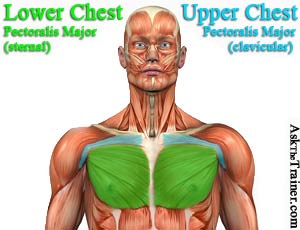 Understanding the basics of chest muscle anatomy will help you maximize the best chest exercises for women.
Understanding the basics of chest muscle anatomy will help you maximize the best chest exercises for women.
The main chest muscle involved in all of our chest exercises here is pectoralis major, also known as the pectorals or simply pecs. There are two heads or origin points of the pectoralis major; the clavicular head, which originates from the middle of the clavicle (collarbone), and the sternal head, which originates from the front of the sternum, the cartilage of the 1st through 6th ribs, and the connective tissue of the external oblique muscle. Both heads stretch across the chest, then insert together into the upper humerus.
The clavicular head of pectoralis major flexes the arm at the shoulder, while the sternal head opposes this action by extending the arm. Both heads work together to internally rotate and adduct the arm.
Different chest exercises can target different parts of the pectoralis major. You don’t need to worry too much about this unless you have very specific chest-building goals. I will make a few notes in the exercise descriptions below about which part of the pecs are being mainly worked by each exercise as well as specific adjustments you can make to work one part or the other.
Although not part of the chest musculature, the anterior deltoid (front of shoulder) and triceps (back of arm) are highly involved in many chest exercises, and pushing motions in general, so follow the links if you would like to learn more about these important muscles.
Exercise Guidelines for the Best Chest Exercises for Women
Following are some tips to help you perform the best chest exercises for women correctly, and to get the most out of your time spent working out.
To perform chest exercises properly, you must be able to stabilize your shoulder blades. To stabilize your shoulders, you must perform a shoulder blade retraction by squeezing your shoulder blades back and together. This will push your chest out a bit, and that’s fine. Shoulder blades held in retraction ensure that the work stays in the pectoralis major instead of getting passed off to the synergist muscles, which can lead to postural problems. The risk of injury is also decreased when you keep your shoulder blades actively retracted during your chest exercises.
You must balance your chest workouts with back workouts to balance your upper body. Overtraining the chest can lead to or exacerbate current hunched posture problems all too common in our society where we spend lots of time hunched in front of screens. You can do all your upper body work on the same day as long as you allow at least 48 hours between training sessions. Alternatively, you can follow a split routine where you work different body parts on different days so you can hit the gym more often without overtraining certain muscle groups.
For general strength and endurance adaptations, aim for sets of between 12 and 20 reps. For maximum strength, go for sets of 6-12 reps. As with all other strength training exercises, the goal is to dial in the amount of weight so your muscles fatigue within the desired rep range.
Since everyone’s fitness level is different, it’s tough to give recommendations about how much weight to use in an article like this. The best advice is to start low and add weight as you learn how much you can handle and as you get stronger. Especially during the chest flies described below, you’ll want to start quite low to avoid shoulder injury.
If you’re working with a split routine (where you train different body parts on different days), it’s appropriate to pair chest work with tricep work since many of the best chest exercises for women work the triceps as well.
Here’s where you can learn all about Sets and Repetitions, and Strength Training Volume.
Finally, make sure to stretch your upper body before and after chest exercises to lubricate joints, increase range of motion, and prevent injury. Also be sure to check out our Upper Body Workout for Women article for even more great exercise tips to build a killer upper body.
Best Chest Exercises for Women
Without further ado, here are the best chest exercises for women. There are many more chest exercises out there, but these are the three basic moves that will give you the most bang for your buck unless you have very specific goals with regard to your chest. Make sure you read and understand the exercise guidelines in the section above to maximize these exercises and prevent injury.
Dumbbell Chest Flies on a Stability Ball
The best chest exercise of all is the dumbbell chest fly (no, not the bench press). This is because the chest fly is the only exercise that truly isolates the chest and leaves synergists such as the anterior deltoids (front of shoulder) or triceps (back of upper arm) out of the mix.
Perform chest flies on a stability ball to engage your core and legs to get more out of this exercise. Since most female exercisers are looking to increase strength while burning plenty of calories to encourage fat loss, flies on a stability ball perform double duty since they get the abdomen and legs involved to stabilize. You will also develop more functional strength by using a stability ball. Functional training addresses real-world strength which helps your perform everyday activities with more ease, grace, and safety.
Resting your back on a stability ball with your knees bent at a 90 degree angle, push the weights up directly overhead before beginning your flies. Remember to keep your shoulder blades retracted as described in the exercise guidelines section above. With palms facing each other, bend your elbows slightly. Inhale as you lower your arms at a 90 degree angle to your trunk until the weights are just slightly above chest level. Then, exhale and push the weights back together up top, squeezing strongly through your chest muscles.
When you’re finished, bring the weights together and then lower them straight down to the fronts of your shoulders before carefully getting up from the ball.
Never perform chest flies with excessive weight, as it’s easy to injure your shoulders doing so. Weight recommendations vary from person to person, so be sure to start low to determine what’s appropriate for your body.
Bench Press on a Stability Ball
Again, we will use a stability ball instead of a traditional bench for our bench press. The reasoning is the same as for the flies described above: more activation of core and leg muscles leading to increased caloric expenditure, greater stabilization, and higher functional strength development.
Make sure the stability ball you’re using is high quality and fully inflated. Watch the video carefully to see how to assume the position on the stability ball under the rack. Your spotter will help you unrack the barbell. Lower the barbell while inhaling, keeping your elbows close to your body. Exhale pushing straight up. When you’re through with your reps, have your spotter guide you as you re-rack the barbell.
The bench press works a good deal of the pectoralis major fairly evenly. How close together your hands are on the bar will change which parts of the pecs are emphasized. A close grip (hands closer than shoulder width) will work the inner chest closer to the sternum, while a wide grip emphasizes the outer chest closer to the shoulders. To evenly work the pecs, simply grip slightly wider than shoulder width.
If you are pressing for maximal strength using heavy weight, you will want to use a traditional weight bench instead of a stability ball. You will also likely want to use a traditional incline or decline bench if you want to target specific areas of your pecs through bench pressing. Using a incline bench (head higher than hip level) will emphasize the upper pecs, while using a decline bench (head lower than hip level) will emphasize the lower pecs.
For more information on how to maximize your bench press, read the following articles:
Chest Press on a Stability Ball
If you don’t have a spotter available, it’s safer to perform a dumbbell chest press than a bench press. Both will yield similar results, but the dumbbells will actually allow you a greater range of motion downward, giving your pecs a good stretch.
Watch the video on the right for a demonstration of a dumbbell chest press.
You can perform this exercise on a stability ball or on a flat bench with or without the hand rotation shown in the video.
Push-Ups
The classic push-up remains one of the best chest exercises for women. It’s a classic for a reason, needing only the resistance provided by your own body weight to provide an extremely effective exercise for the pectorals, anterior deltoid (front of shoulder) and triceps (back of upper arm). The tighter you keep your elbows to your body, the more the triceps are emphasized.
Always begin your push-ups flat on the ground to build functional strength. With your hands flat on the floor next to your elbows and your elbows kept tightly against your sides, push yourself off the ground. Keep your ear, shoulder, hip, knee, and ankle in perfect alignment as if you have a racing stripe painted down the side of your body. Refuse to let your core sag, or your butt to lift in the air. Be careful not to snap your elbows at the top.
Push-ups are good at any time in a chest workout, but work especially well at the end of a chest workout to totally burn out the chest muscles. Don’t worry about how many you can do or how fast you are going. The most important aspect of building chest strength is the time the muscles are under tension. If you bust out twenty pushups in ten seconds or only get through five, it doesn’t really matter as long as you maintain good form and muscle tension the whole time.
Bent-knee push-ups (AKA “girl” push-ups) are not recommended as they fail to build functional strength or engage the core as much as straight push-ups. If you struggle to perform regular push-ups, you can work up to them slowly by raising the incline of your upper body. You can do push-ups with your hands against a wall as the easiest variation, then move to a counter top, then a weight bench, then finally the floor as you get stronger!
If regular push-ups don’t provide enough of a challenge for you, try raising the incline of your feet by placing your feet on a bench or stability ball. As with any exercise progression, make sure you are totally comfortable performing straight push-ups with perfect form before you attempt to progress.
Plyometric Push-Ups
If you would like to build explosive strength and power in your chest, make like Rocky and try plyometric pushups! Instead of merely pushing yourself upright, you push explosively so that your hands leave the floor. Quickly clap, and then catch yourself with your hands and lower down to complete one rep.
Make sure you have stable wrists and shoulders and that your maintain your straight “racing stripe” as in the classic push-up when you do plyometric push-ups.
About Mae Barraclough
Mae Barraclough, B.S., NASM-CPT, NASM-CES is a certified personal trainer, corrective exercise specialist, and licensed Zumba Instructor. With her passion for health, fitness, and dance, Mae loves learning all she can and sharing her knowledge with others.

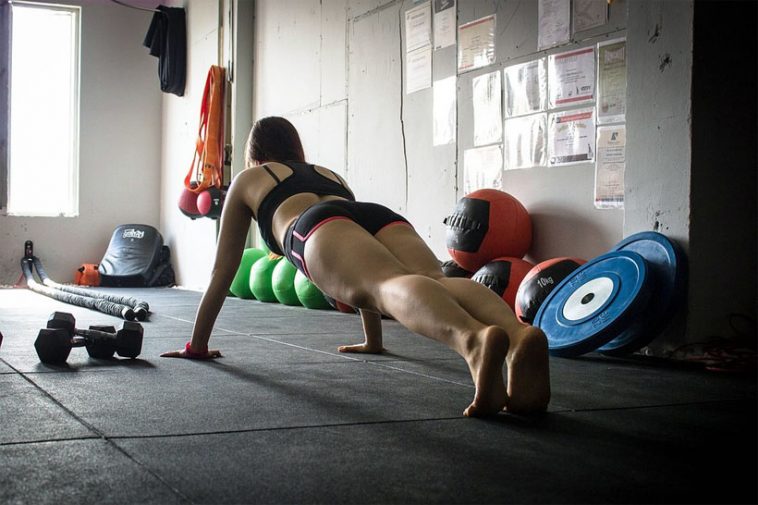
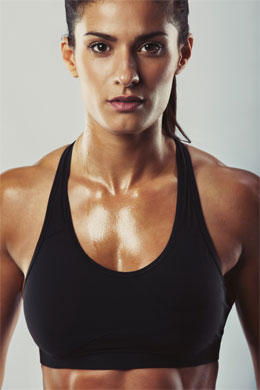 Sculpt, Trim, and Tone Your Upper Body With this Killer Chest Workout
Sculpt, Trim, and Tone Your Upper Body With this Killer Chest Workout